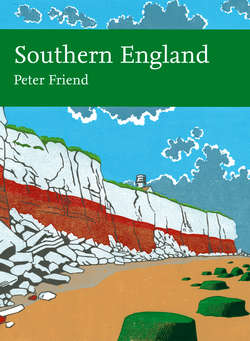Читать книгу Southern England - Peter Friend - Страница 37
Landscape C: Cornish killas
ОглавлениеMost of the bedrock of West Cornwall is Devonian sediment, folded, faulted and – locally – altered during the Variscan mountain-building episode (see the general section of this chapter). The Devonian sediments, known to miners and quarrymen as killas, have been less resistant to landscape weathering and erosion than the granites (A) and the Lizard Complex (B), and so have been preferentially eroded to form lower landscapes. All the major bays and estuaries of this Area, such as St Ives Bay (c4) and the Carrick Roads at Falmouth (c7), are situated in killas areas for this reason. The Variscan folding and faulting that deformed the killas has also locally influenced the directions of valleys and their slopes, which have picked out variations in the killas layering, giving an east-west grain to the landscape (Fig. 61).
FIG 61. Slope map of the eastern part of West Cornwall. The main granite bedrock areas are outlined and important boundaries in the Devonian bedrock indicate the direction of the Variscan folding. Note the circular china-clay workings that are visible in the St Austell granite (A5).
FIG 62. Complex landscape of the North Cornwall coast, looking eastwards from Crantock Beach, over the Pentire Ridge towards Newquay (Fig. 52, c2) and Watergate Bay. (Copyright Dae Sasitorn & Adrian Warren/ www.lastrefuge.co.uk)
FIG 63. Headlands, bays and beaches of the Newquay area (Fig. 52, c2), looking eastwards from a point 2 km west of Figure 62. Crantock Beach is visible in the middle distance. (Copyright Dae Sasitorn & Adrian Warren/www.lastrefuge.co.uk)
The Flandrian sea-level rise, which ended only 5,000 years ago, has also left its mark on West Cornwall. The most obvious legacy is the extensive array of tidal estuaries at the mouths of the main rivers, which are flooded river valleys or rias. The most striking example is the series of branched rias around Falmouth known as the Carrick Roads (c7). These extend northwards across half of the width of West Cornwall and have had an obvious major influence on the road and rail transport pattern of the area. Major branch rias to the west, north and east around the Carrick Roads divide this part of the Cornish landscape into numerous isolated peninsulas. The inland valleys of the killas areas tend to be deeply incised with little widening, and the branching patterns of these valleys are very clear on the slope map. The rias are obviously the direct result of the drowning of valleys of this form by the Flandrian sea-level rise.
The coastline of the killas landscape of West Cornwall is extremely varied: small, sandy coves alternating with rocky promontories and high cliffs are typical of this part of the north coast (Figs 62 and 63). This irregular coastline is due to local variation in the type and strength of the killas bedrock, with weaker units (often slates) eroding to small bays while the more resistant rocks (often limestones or quartzites) form the headlands.
The sandy bays of north Cornwall (c1, Padstow and the River Camel Estuary; c2, Newquay Bay; c3, Perranporth and Perran beach; c4, St Ives Bay) are famous for surfing, due to the splendid waves that roll in from the Atlantic Ocean. Apart from Padstow Bay (c1), at the mouth of the River Camel, most of the north Cornwall beaches are not obviously linked to river sources of sand and so must have been filled by sand transported from offshore sources by storm waves. At many famous surfing beaches, such as Perranporth (c3), sand banks built up by winter storms can be eroded in the summer, resulting in dangerous currents sweeping out to sea. The wind-blown dunes of the Penhale Sands, north of Perranporth, are a spectacular example of the way that gales from the west can move beach sand up to 2 km inland. Because of the variation in the killas bedrock, some headlands are long and the inlets are narrow enough to develop fast tidal flows, capable of forming large, regular ripples as seen in the foreground of Figure 62.
On the south coast, storm-built sandy beaches have also formed, for example at Newlyn (c8), Praa Sands (c5) and at the mouth of Helston valley south of Porthleven (c6). Further east, the coastline is much more sheltered and the scenery is dominated by the drowned valleys and quiet inlets of the Carrick Roads (c7).
